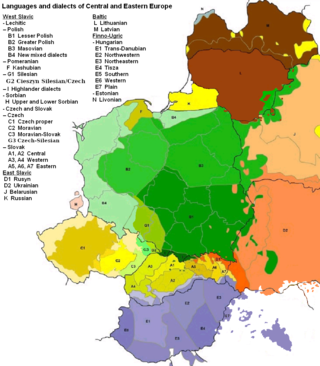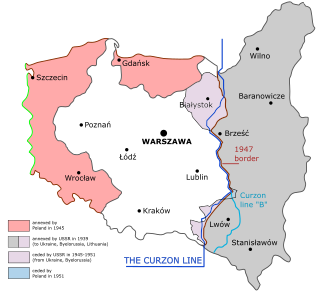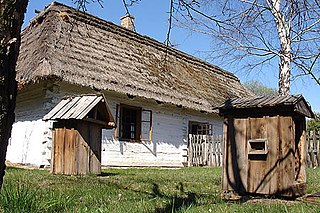Kashubian or Cassubian is a West Slavic language belonging to the Lechitic subgroup along with Polish and Silesian. Although often classified as a language in its own right, it is sometimes viewed as a dialect of Polish.

Polish is a West Slavic language of the Lechitic group within the Indo-European language family written in the Latin script. It is primarily spoken in Poland and serves as the official language of the country, as well as the language of the Polish diaspora around the world. In 2023, there were over 40.6 million Polish native speakers. It ranks as the sixth most-spoken among languages of the European Union. Polish is subdivided into regional dialects and maintains strict T–V distinction pronouns, honorifics, and various forms of formalities when addressing individuals.

The Pomeranian language is in the Pomeranian group of Lechitic languages within the West Slavic languages.

Silesian, occasionally called Upper Silesian, is an ethnolect of the Lechitic group spoken by part of people in Upper Silesia. Its vocabulary was significantly influenced by Central German due to the existence of numerous Silesian German speakers in the area prior to World War II and after. The first mentions of Silesian as a distinct lect date back to the 16th century, and the first literature with Silesian characteristics to the 17th century.
Tutejszy was a self-identification of Eastern European rural populations, who did not have a clear national identity. The term means "from here", "local" or "natives". This was mostly in mixed-lingual Eastern European areas, including Poland, Ukraine, Belarus, Lithuania, and Latvia, in particular, in Polesia and Podlachia. As a self-identification, it persisted in Lithuania’s Vilnius Region into the late 20th century. For example, in 1989, a poll of persons whose passports recorded their ethnicity as Polish revealed that 4% of them regarded themselves as tuteišiai, 10% as Lithuanians, and 84% as Poles.

Eastern Borderlands or simply Borderlands was a term coined for the eastern part of the Second Polish Republic during the interwar period (1918–1939). Largely agricultural and extensively multi-ethnic with a Polish minority, it amounted to nearly half of the territory of interwar Poland. Historically situated in the eastern Polish–Lithuanian Commonwealth, following the 18th-century foreign partitions it was divided between the Empires of Russia and Austria-Hungary, and ceded to Poland in 1921 after the Treaty of Riga. As a result of the post-World War II border changes, all of the territory was ceded to the USSR, and none of it is in modern Poland.

The West Slavic languages are a subdivision of the Slavic language group. They include Polish, Czech, Slovak, Kashubian, Upper Sorbian and Lower Sorbian. The languages have traditionally been spoken across a mostly continuous region encompassing the Czech Republic, Slovakia, Poland, the westernmost regions of Ukraine and Belarus, and a bit of eastern Lithuania. In addition, there are several language islands such as the Sorbian areas in Lusatia in Germany, and Slovak areas in Hungary and elsewhere.
Wymysorys, also known as Vilamovian or Wilamowicean, is a West Germanic language spoken by the Vilamovian ethnic minority in the small town of Wilamowice, Silesian Voivodeship, Poland, on the border between Silesia and Lesser Poland, near Bielsko-Biała. It is considered an endangered language, possibly the most so of any of the Germanic languages. There are probably fewer than 20 native users of Wymysorys, virtually all bilingual; the majority are elderly.

The Warsaw subdialect, or Warsaw dialect, is a regional subdialect of the Masovian dialect of the Polish language, centered on the city of Warsaw. It evolved as late as the 18th century, under notable influence of several languages spoken in the city. After the destruction of Warsaw in the aftermath of the Warsaw Uprising of 1944 the subdialect has been in decline. It is estimated that in modern times it is almost extinct as the native language and is preserved mostly in literary works.

The culture of Poland is the product of its geography and distinct historical evolution, which is closely connected to an intricate thousand-year history. Poland has a Roman Catholic majority, and religion plays an important role in the lives of many Polish people. The unique character of Polish culture developed as a result of its geography at the confluence of various European regions.

The Masovian dialect, also written Mazovian, is the dialect of Polish spoken in Mazovia and historically related regions, in northeastern Poland. It is the most distinct of the Polish dialects and the most expansive.
The Lwów dialect is a subdialect (gwara) of the Polish language characteristic of the inhabitants of the then Polish city of Lviv, now in Ukraine. Based on the substratum of the Lesser Polish dialect, it was heavily influenced by borrowings from other languages spoken in Galicia, notably Ukrainian (Ruthenian), German and Yiddish,

Lasovians are a subethnic group of the Polish nation, who reside in Lesser Poland, at the confluence of the Vistula and the San rivers, Subcarpathian Voivodeship, southeastern Poland. They are descended from various ethnic groups, which settled in the dense Sandomierz Forest across centuries, with a dominant Polish element. The Lasowiacy were formed as a separate subethnic group in the late 19th and early 20th century. They use their own dialect, which belongs to Lesser Polish dialect cluster of the Polish language. Like most Poles, the Lasowiacy are Roman Catholics.
The Belarusian minority in Lithuania numbered 36,200 persons at the 2011 census, and at 1.2% of the total population of Lithuania, being the third most populous national minority. The Belarusian national minority in Lithuania has deep historical, cultural and political relations. Many famous Belarusians lived and created in Lithuania, mostly its capital Vilnius; it was in Vilnius that the first standardized Belarusian language grammar was printed.
Agnieszka Biedrzycka is a Polish historian and writer from the Institute of History of the Polish Academy of Sciences (PAN). She obtained her doctorate in December 2002 from the Faculty of History of the Jagiellonian University in Kraków, Poland. Biedrzycka serves as research scientist and editor for the multi-volume Polish Biographical Dictionary published by PAN incrementally. She is in charge of the History of Poland in the Early Modern era department. Since the 1989 return to democracy from under the Soviet-led totalitarian control, many distortions printed there have already been corrected. Her professional interest in research work gave impetus to the book about the history of Lwów in the Second Polish Republic before the invasion of Poland, which was followed by the systematic destruction of the city's Polish heritage by the Soviet Union.

Janusz Andrzej Rieger is a Polish linguist and slavist specializing in the history of Polish language in Kresy, professor of the humanities, member of the Warsaw Scientific Society. He worked at the Institute of Slavic Studies and at the Institute of Polish Language of the Polish Academy of Sciences, and lectured at the University of Warsaw.
Simple speech, also translated as "simple language" or "simple talk", is an informal reference to various uncodified vernacular forms of Ukrainian and Belarusian in the areas historically influenced by Polish culture.

Chełmnian–Kocievian–Warmian dialect is a group of dialects of Polish language used in the Kuyavian-Pomeranian, Pomeranian, and Warmian-Masurian Voivodeships. It is considered by some linguists as a branch of the Greater Poland dialect, while also, as a separate dialect, by others.

Northern Borderlands dialect is a dialect of the Polish language, spoken by the Polish minorities in Lithuania and in northwestern Belarus.

Southern Borderlands dialect is a dialect of the Polish language, spoken by the Polish minority in Ukraine. It is considered a branch of the Lesser Poland dialect by Zofia Kurzowa.













